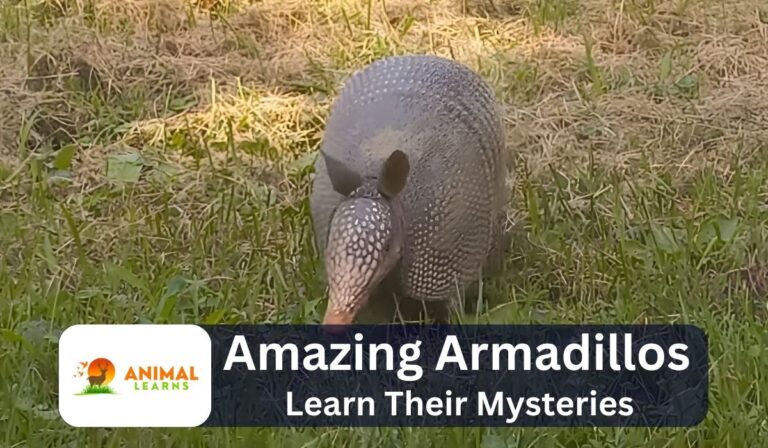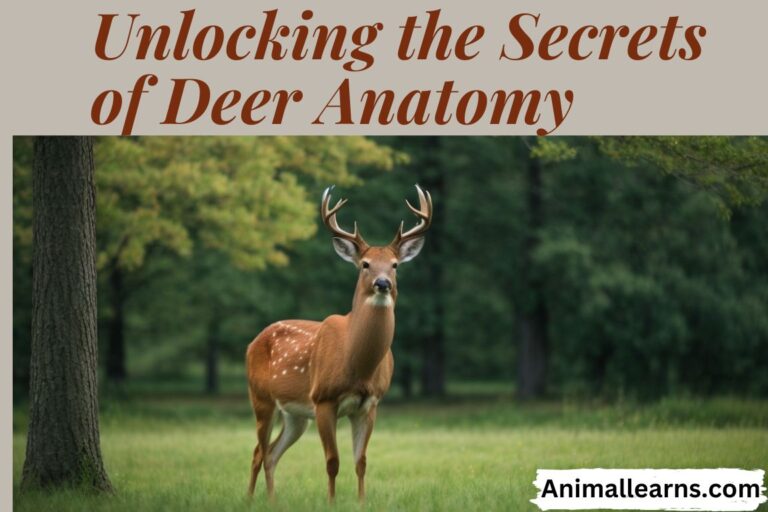Andean Bear: Diet, Habitat, and Interesting Facts
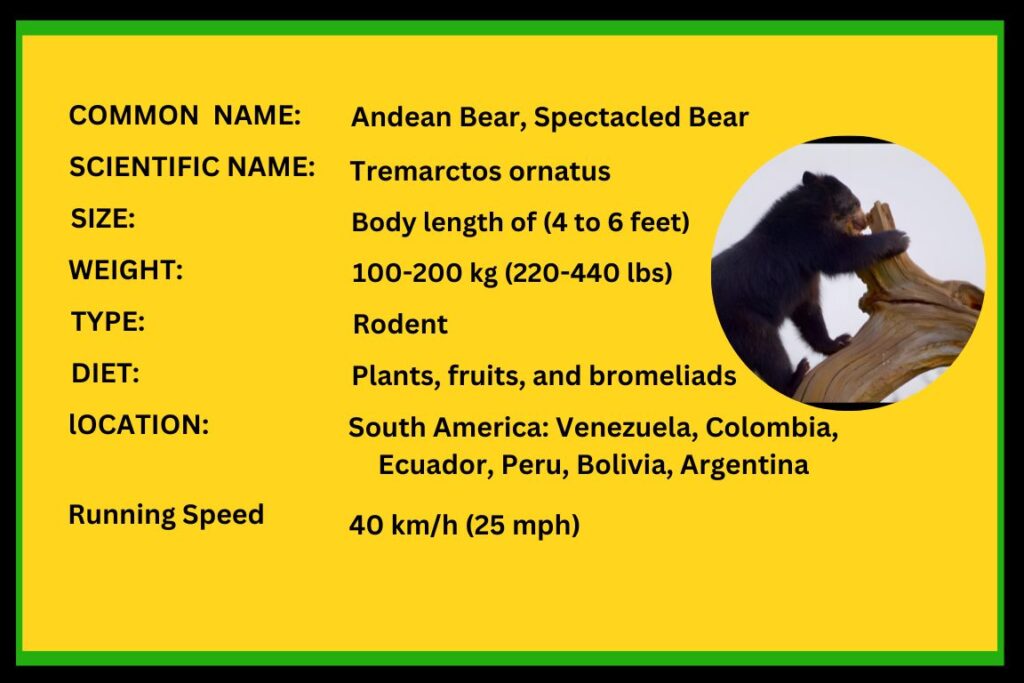
The Andean bear, also known as the spectacled bear due to distinctive facial markings, is a fascinating species native to the high-altitude regions of South America. In terms of size, Andean bears are considered the largest bear species in South America, with males weighing up to 440 pounds.
Despite its herbivorous diet, the spectacled bear is a powerful and agile creature, capable of running at speeds of up to 40 km/h, a trait it shares with the black bears and brown bears.
Their size and physical characteristics distinguish them from other bear species, sparking interest in comparisons, such as the Andean bear vs the sun bear. This unique species showcases a remarkable range of adaptations to its habitat, which primarily consists of montane forests, cloud forests, and grasslands.
Unfortunately, they face endangerment due to habitat loss and human-wildlife conflicts, emphasizing the importance of conservation efforts and organizations like the spectacled bear Foundation.
The Appearance
Contents
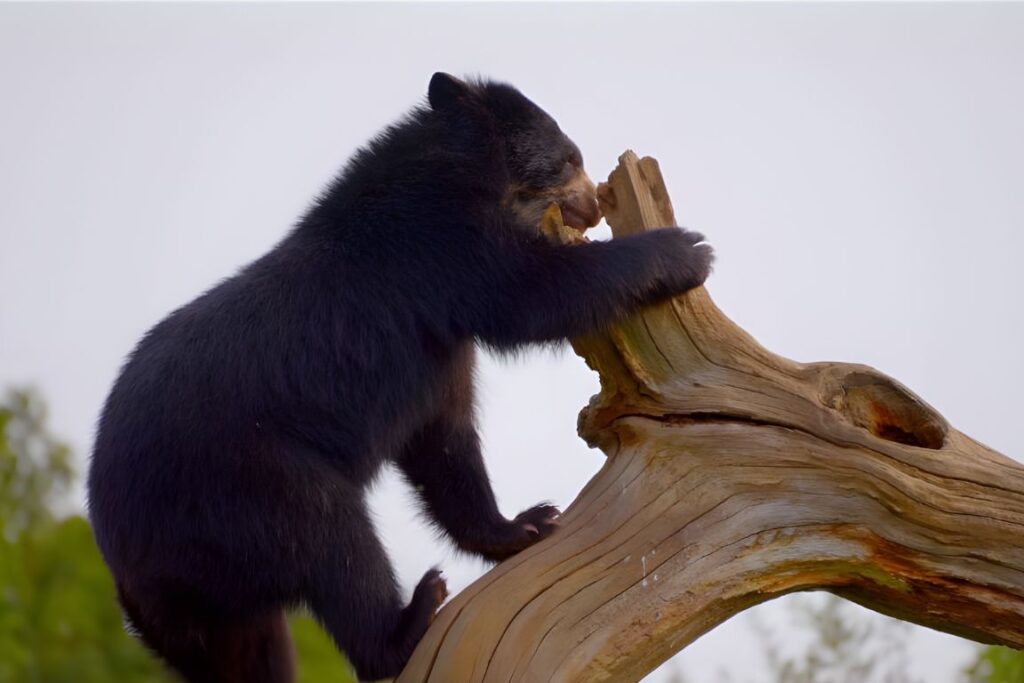
As their alternative name suggests, spectacled bear can be easily recognizable by their distinctive markings around their eyes, which resemble spectacles.
Some individuals may have a distinct chest marking on their shaggy fur, while others may have black to brown fur. Their rugged mountainous surroundings make them well suited to their robust build and short snout.
Diet of Andean Bear
They are primarily herbivores, with their diet consisting mainly of vegetation such as fruits, cacti, and bromeliads. However, they are known to supplement their diet with insects, small mammals, and birds. This flexibility in their diet allows them to adapt to the diverse environments within their range.
Life Cycle
They usually live solitary lives, mating during the dry season. Female spectacled bears give birth to one or two cubs after a gestation period of between 6 and 7 months. Before venturing out on their own, the cubs stay with their mother for an extended period of time, learning important survival skills.
Habitat

Located in the Andes and outlying mountain ranges, and from western Venezuela south to Bolivia, the spectacled bear is South America’s only bear. They live in a variety of mountain habitats in the Andes, from eastern Panama to extreme northern Argentina.
The majority live between 6,000 and 8,800 feet (1,829 to 2,682 meters) above sea level, but others live below this level. The habitat consists of rainforests, cloud forests, mossy, stunted elf forests, and thorny dry forests. Aside from grasslands, they will also forage in forests.
Interesting Facts
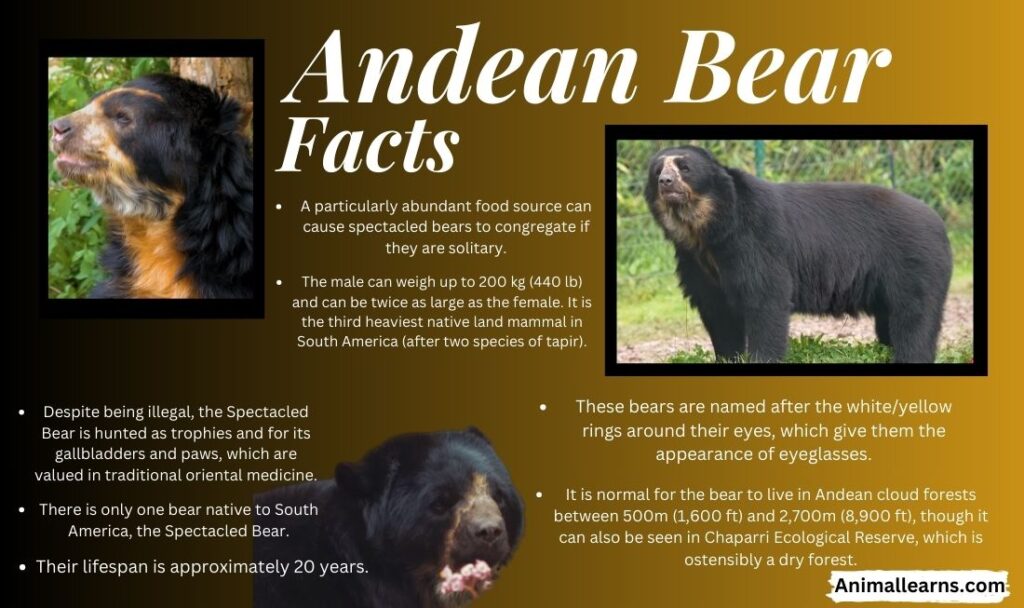
- A particularly abundant food source can cause spectacled bears to congregate if they are solitary.
- The male can weigh up to 200 kg (440 lb) and can be twice as large as the female. It is the third heaviest native land mammal in South America (after two species of tapir).
- Despite being illegal, the Spectacled Bear is hunted as trophies and for its gallbladders and paws, which are valued in traditional oriental medicine.
- There is only one bear native to South America, the Spectacled Bear.
- These bears are named after the white/yellow rings around their eyes, which give them the appearance of eyeglasses.
- Their lifespan is approximately 20 years.
- Having longer front legs than rear legs makes climbing trees easier. They are excellent climbers and usually spend a lot of time in trees.
- It is normal for the bear to live in Andean cloud forests between 500m (1,600 ft) and 2,700m (8,900 ft), though it can also be seen in Chaparri Ecological Reserve, which is ostensibly a dry forest.
Distribution
Among the South American countries where the spectacled bear is found are Venezuela, Colombia, Ecuador, Peru, Bolivia, and northwest Argentina. In addition to thriving in tropical forests, they can also thrive in high-altitude Andean peaks, demonstrating how adaptable they are.
Behavior and lifestyle
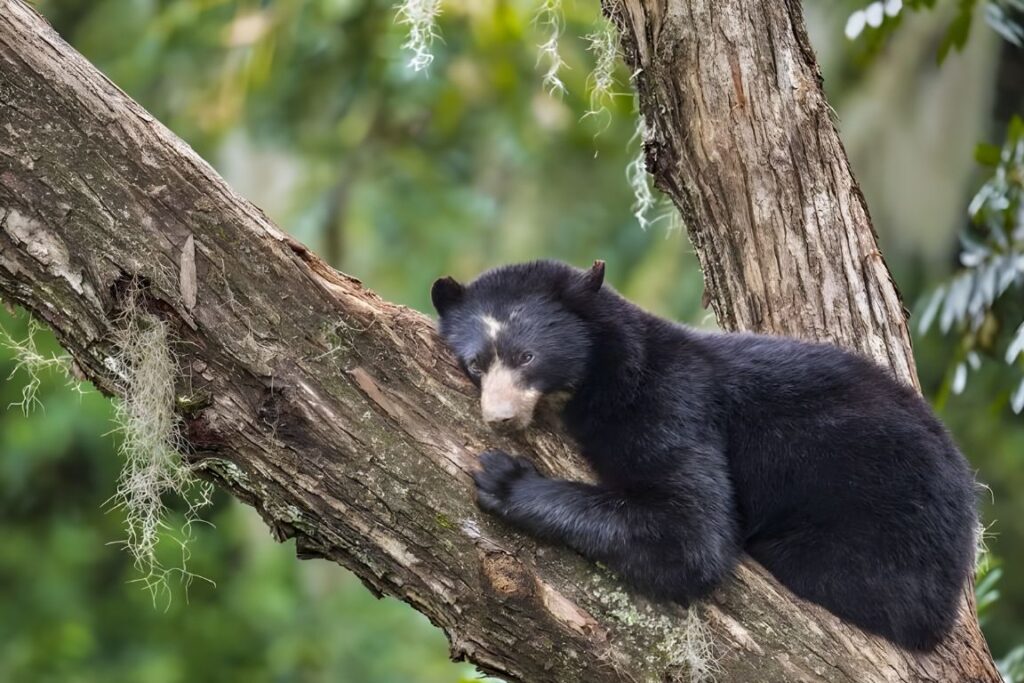
Its primary behavior is nocturnal, avoiding the heat of the day by resting in trees or hidden areas at night. There are occasionally social interactions between these bears during mating season and between mothers and their cubs, which contribute to their survival in their diverse habitats. These bears are excellent climbers and swimmers.
Adaptations
A mountainous environment has developed unique adaptations for these bears. They traverse steep, uneven terrain with ease thanks to their strong, stocky build and powerful limbs. Their distinct facial markings are also thought to facilitate communication between individuals.
As well as providing refuge from predators, their keen sense of smell aids in locating food sources in dense vegetation.
Reproduction
spectacled bears, also referred to as spectacled bears, have a relatively slow reproductive rate. Females typically give birth to one or two cubs after approximately seven months of gestation. Cubs are born in a secluded den, and their mothers devote considerable time and effort to nurturing and caring for them.
The cubs stay with their mother for a long period of time, often for about a year and a half, during which they learn survival skills like foraging and climbing. Andean Bear are threatened by habitat loss and human-wildlife conflicts because of their slow reproductive rate and extended parental care.
Population
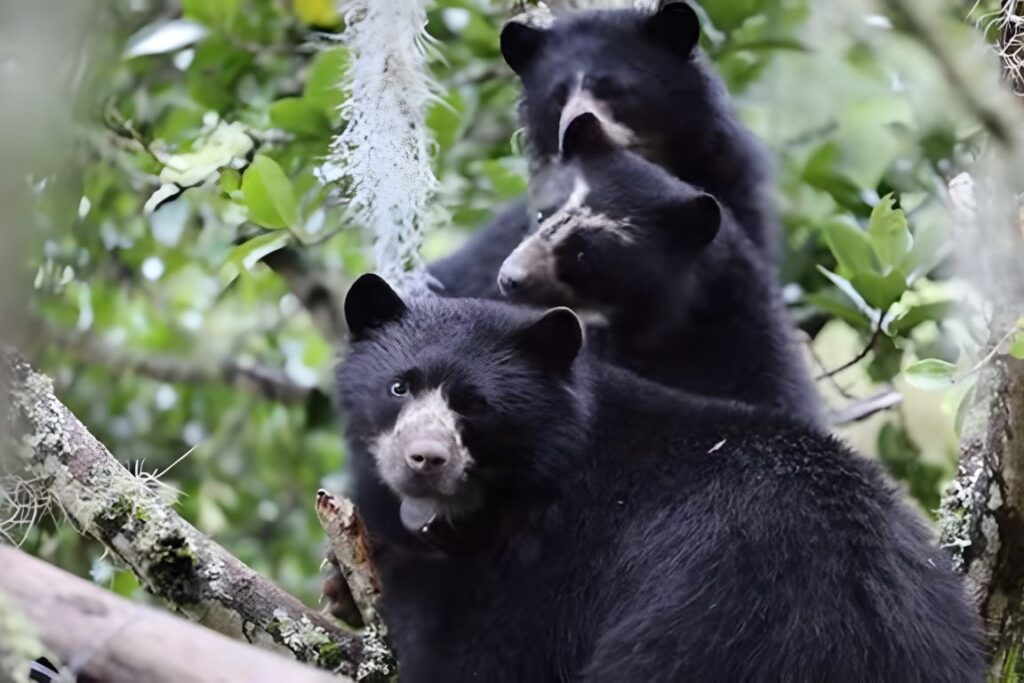
They are primarily found in the Andes Mountains of South America, spanning several countries, including Venezuela, Colombia, Ecuador, Peru, Bolivia, and parts of northwest Argentina.
The exact population of bears is challenging to determine due to their elusive nature and the remote habitats they inhabit. However, they are listed as a vulnerable species by the International Union for Conservation of Nature (IUCN) due to habitat destruction, fragmentation, and hunting.
Conservation efforts are crucial to ensuring the survival of spectacled bear populations, including habitat preservation, reducing human-bear conflicts, and raising awareness about the importance of their conservation.
Social Systems
It is the mother and her cubs that form the cornerstone of the social fabric of the bear, Tremarctos ornatus. The bear weaves a social tapestry in the elevated realms of the Andes, demonstrating a nuanced family structure.
During their extended time in these high-altitude abodes, the cubs acquire survival skills, as well as integrate into a loose network of loose affiliations.
These bears navigate their mountainous domain with a harmonious blend of familial bonds and spatial acumen, avoiding conflicts and embodying a social finesse unique to their herbivorous existence, despite encounters between them being infrequent.
Olfactory messages left on the rugged terrain serve as a sophisticated means of communication.
Predators
Despite being apex predators in their native habitats, they have few natural predators. Humans are the primary threat to their survival, including habitat destruction, poaching, and conflict.
Although adults do not pose a significant threat to spectacled bears, cubs are susceptible to predators such as cougars and other large carnivores. Keeping their habitats in balance is crucial not only for the bears themselves but also for the ecology.
Mating

In most cases, these bears mate during the breeding season, but this can vary based on the region where they live. Females are actively sought out by males, who interact vocally, with scent marks, and physically with them.
In a successful mating, female cubs prepare a den for their upcoming birth. The mating process can be complex, involving both aggressive and gentle interactions between mates.
For conservation efforts aimed at ensuring the long-term viability of spectacled bear populations, understanding their reproductive behavior is crucial.
Challenges Faced

Tremarctos ornatus, the Andean bear, faces many challenges in its high-altitude habitat. Human activities disrupt bear movements and disrupt migratory routes, potentially causing genetic isolation.
Encroachment by human settlements causes direct conflicts and retaliatory killings. Poaching, fueled by the demand for body parts and the illegal pet trade, poses a persistent threat. These bears are elusive and have rugged terrain, making comprehensive research difficult due to climate change.
An approach that addresses ecology, society, and economics and fosters coexistence between humans and this enigmatic species is imperative to ensuring the spectacled bear’s survival.
FAQs
What is the Spectacled Bear’s Habitat?
Learn about the distinctive habitat preferences of the spectacled bear, including the altitudes and ecosystems they inhabit in the Andean region.
What Threats Do Spectacled Bears Face?
Explore the various challenges and threats confronting spectacled bears, from habitat fragmentation to human-wildlife conflict, poaching, and the impacts of climate change.
How Does Andean Bear Behavior Differ from Other Bear Species?
Discover the unique behavioral characteristics of spectacled bears and understand how they differ from their bear counterparts in other parts of the world.
What Conservation Efforts Are in Place for Spectacled Bear?
Gain insights into the ongoing conservation initiatives aimed at protecting bears, including research, habitat preservation, and community engagement.
What Role Do Andean Bears Play in the Ecosystem?
Explore the ecological significance of spectacled bears and understand their role in maintaining the balance of the Andean ecosystem, including their interactions with other species and plant life.











